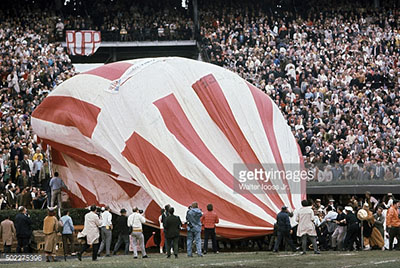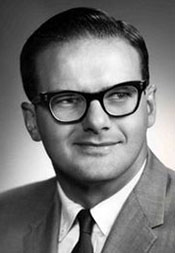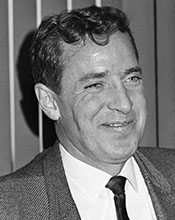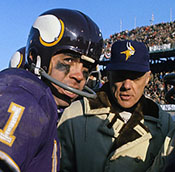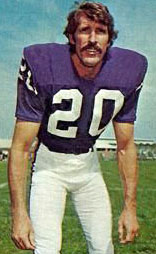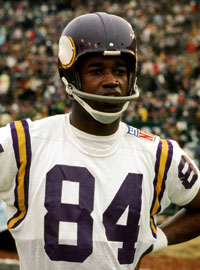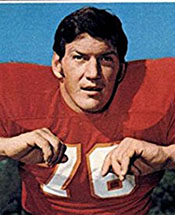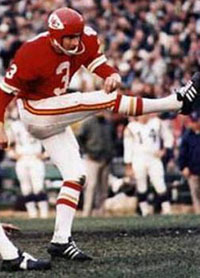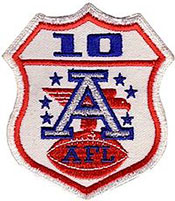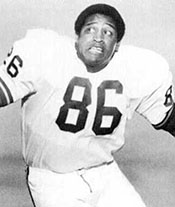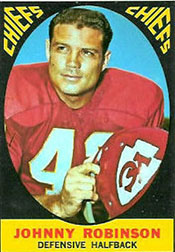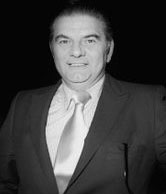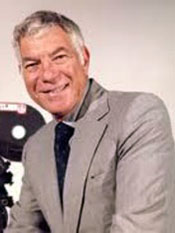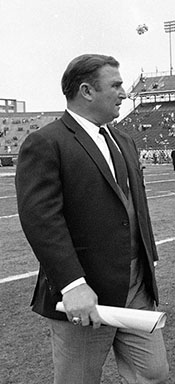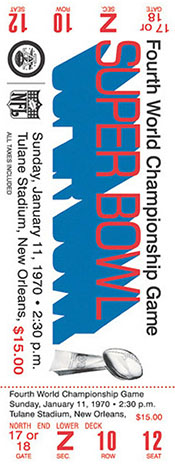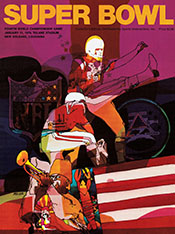1969: Super Bowl IV - Kansas City Chiefs vs Minnesota Vikings
This series covers the history of the NFL through the prism of its yearly championship games.
Note: The gray boxes contain asides that provide interesting material but could be skipped
without losing the continuity of the article.
|
|
The Minnesota Vikings joined the NFL as an expansion team in 1961 in part to take a franchise away from the fledgling American Football League.
Like expansion teams in every sport, the Vikings started slowly.
- After just ten wins in their first three seasons, they broke the .500 barrier in 1964 with an 8-5-1 record under Norm Van Brocklin, who retired from the Philadelphia Eagles after leading them to the 1960 NFL championship to take charge of the Vikings. When the team receded to 7-7 in '65 and 4-9-1 in '66, General Manager Jim Finks replaced Van Brocklin with Bud Grant.
Finks also had a background in the CFL as a QB, coach, and GM.
- Grant came from the Canadian Football League, where he had won the Grey Cup four times as head coach of the Winnipeg Blue Bombers. Known for instilling discipline in his teams and his stoic demeanor on the sidelines, Bud led Minnesota to an 8-6 finish and a playoff berth in his first season, 1968.
The son of a fire chief, Grant overcame polio at age five to go on and win nine varsity letters in football, basketball, and baseball at the University of Minnesota. He played with George Mikan on the NBA's Minneapolis Lakers for two years before joining the Philadelphia Eagles as a two-way end in 1950.
In Year Two of the Grant Era, the Vikings jumped to the top of the NFL.
- Led by unorthodox QB Joe Kapp, Minnesota compiled the best record in the league, 12-2.
The 31-year-old Kapp had come to the Vikings in 1967 after seven seasons in the Canadian League that included three straight Grey Cup appearances with Calgary with one victory. He developed a reputation as a great leader and a tough player who liked to run and didn't shy away from contact. In other words, exactly the type of QB for a Bud Grant team.
- The heart of Grant's club was the most intimidating defense in the NFL. The dominance started up front with the "Purple People Eaters":
DEs Carl Eller and Jim Marshall
DTs Gary Larsen and Alan Page
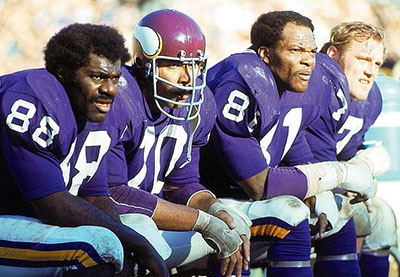
The Purple People Eaters
L-R: Carl Eller, Jim Marshall, Alan Page, Gary Larsen
- Bobby Bryant (8 INTs), Earsall Mackbee (6 INTs), and Paul Krause (5 INTs) led the secondary.
- The conservative offense was built around the running of Dave Osborn behind a relatively small O-line and short and medium range passes to All-Pro WR Gene Washington.
- With home field advantage throughout the playoffs, the Vikings dispatched the Los Angeles Rams 23-20 in another Ice Bowl (10°, wind chill -1°) before cruising past the Browns 27-7 in even chillier conditions (8°, wind chill -6°).
Ironically, the Vikings' opponent in Super Bowl IV would be the Kansas City Chiefs, owned by the Lamar Hunt, the man who invited Minneapolis to field a team in his new AFL in 1960.
- Hank Stram felt his club was much improved from the AFL's first Super Bowl representative in 1966, especially on defense.
- Joe Namath and many scouts felt that Stram's team had the best talent in the AFL. Yet the Chiefs had made the postseason only twice ('62 as the Dallas Texans and '66).
In the summer of '69, Stram sent a letter to each player explaining his new grooming regulations. No long hair falling below the bottom of the helmet; no mustaches, goatees; no sideburns longer than his own.
In an era of racial strife (with numerous riots in the explosive summer of 1968), the Chiefs had developed what Michael MacCambridge called a slangy, unforced camaraderie with the good ol' boys from the South mixing freely with the wide assortment of Southern blacks. The Chiefs may have made fun among themselves of the dictatorial ways of Stram, whom they called "Little Caesar," but they all agreed their coach was devoid of prejudice. One player recalled: There were some people who thought he put form over substance, but it was clear, when it came to race, he didn't care about color, he only cared if you could play.
- New offensive starters since '66:
RG Mo Moorman
FB Robert Holmes
PK Jan Stenerud
Born in Norway, Stenerud came to Montana State University on a skiing scholarship. I was messing around one day on the practice field when the football coaches saw me kicking the ball. They asked me to come out for the team. I didn't know a thing about football. I played a little soccer but no football. It's not very big in Norway. My folks back home still aren't sure of what I'm doing for a living over here. Anyway, I kicked some in college and when the Chiefs drafted me, I said, "What the heck. Why not?" Jan was inducted into the Pro Football Hall of Fame in 1991.
- New defensive starters since '66:
DT Curly Culp
MLB Willie Lanier
LB Jim Lynch
CB Jim Marsalis
- The defense, which DT Buck Buchanan rated as 80% better than the KC D in Super Bowl I, led the league in fewest rushing yards, fewest passing yards, and fewest total yards. However, QB Lenny Dawson was hampered by a serious knee injury in Game Two that restricted him to starting only six games. Even when he returned, he dragged his stiff leg.
- The Chiefs had to make the playoffs as a wild card after losing to the Raiders twice in the last four weeks by a total of seven points. But they upset the defending champion Jets 13-6 in New York before turning the tables on the Raiders in Oakland 17-7. The KC defense gave up only 13 points to two of the best offenses in the league on the road in the last games of the American Football League before the merger with the NFL for the 1970 season.
The Raiders were so confident of victory in their third meeting with the Chiefs that they brought their packed bags for the trip to New Orleans so that they could leave right after the game. Dawson: Their parking area for their cars when they drove to the game was near where the buses are. After we beat them, they had to walk with their baggage in hand past us to put them in the car trunks to head back home. I never let them forget that when I would see Raiders players after that.
Apparently thinking the Jets' upset of the Colts in Super Bowl III was a fluke, the oddsmakers installed the Vikings as 13-point favorites.
Stram must have thought he was back in Super Bowl I as he watched films of Minnesota.
- Their offense was as straightforward and simple as that of Green Bay. The Vikes ran the ball 59% of the time (489 snaps to 346). Dave Osborn (643y on 186 attempts) and Bill Brown (430/126) accounted for slightly over 1,000y on the ground.
The Chiefs' defense had been given 20 sheets of offensive formations before their game with the Raiders for the AFL championship. Analysis of the Vikings' films produced a mere four pages. DE Jerry Mays walked out of a meeting on Wednesday of Super Bowl week and bragged to the Chiefs PR man, If Jan-ski (Stenerud) can make three field goals, we're going to win the game. There is no way they're going to score more than a touchdown.
- Gene Washington led in receptions with only 39 while the other WR, John Henderson, grabbed 34 and TE John Beasley, 33.
- Like Lombardi's Packers, the Vikings stayed with a basic 4-3 defense. They didn't need to blitz much because of the effectiveness of the People Eaters. They saw no reason to change since they allowed an NFL modern-record low 133 points during the regular season.
Sacks were not yet recognized as a statistic. Deacon Jones, Los Angeles Rams DE, had just coined the term a few years earlier.
- The Chiefs' offensive unit were licking their chops, much as Namath's Jets did the year before after studying the Colts' defense.
- Stram and his veterans from the '66 squad had been waiting for another chance at the NFL for three years. The players and assistant coaches also wanted to erase the stain on Stram's reputation from the lopsided loss in Super Bowl I.
Dawson recalled: My main goal in football was to have a second opportunity to win a Super Bowl and erase Lombardi's cutting remark about our team and league.
Lamar Hunt also had special motivation to win Super Bowl IV. He hosted a dinner Wednesday night at Antoine's Restaurant in the French Quarter for family and friends. The founder of the AFL couldn't help but reflect on the irony of playing the Minnesota Vikings in the Crescent City. New Orleans had agreed to host the 1965 AFL All-Star game, the first one hosted outside one of the league's member cities. But the segregated Deep South city wasn't ready to host an event with integrated rosters. Black players couldn't get cabs and were denied access at some restaurants and night clubs. Led by Clem Daniels, Ernie Ladd, and Cookie Gilchrist, they banded together and decided to boycott the game. As a result, it was hurriedly moved to Houston.
So Hunt spoke frankly to his gathering at Antoine's. Two things stand out in my mind. One is the way New Orleans treated the American Football League. The other is the way some of the men who are now owners of the Vikings pulled out on us after committing themselves to an NFL franchise. In looking back on these things, all I think of tonight is ... (pausing and banging his fist on the table) ... kill ... kill ... KILL! ... KILL!
Soon the entire dining room joined in the chant: KILL! KILL!
A big reason Minnesota's offense resembled Green Bay's was that Jerry Burns had been a Green Bay assistant in the first two Super Bowls.
- Serving as what today would be called the "offensive coordinator," Burns knew from watching films that KC's defense was much improved and that We were not nearly as strong as Green Bay.
- Bud Grant complained about the short preparation time for the game. It's hard to plan for a team when you've only seen them on three films. We've got nine years of Bart Starr on film. All we know about the Chiefs is that their style is similar to that of the Dallas Cowboys.
- Jerry Reichow, the Vikings personnel director, studying the Chiefs on film, realized they were much better than most observers recognized.
- As for Snyder's belief that the Minnesota O-line was the best ever, Reichow said, We had a good offensive line. I don't think we had a great one.
For the first time, only one week separated Super Bowl Sunday from the league championship games.
- Stram: Quite honestly, I preferred the week's time span and saw it as a distinct advantage. I felt the variety of our offense would present a definite problem for Minnesota. I snickered to myself because this was the one game I was confident about.
- But little did Hank know that the week would start with a monumental distraction.
Right as the Chiefs arrived in New Orleans, news out of Detroit about "the biggest gambling investigation of its kind ever" almost overshadowed the Super Bowl.
- A special Justice Department Task Force revealed the names of seven pro football players who would be questioned about their relationship with known gamblers.
- The most notable of the seven was Kansas City QB Len Dawson, who admitted to knowing Donald "Dice" Dawson (no relation), the most notable of the FBI's targets.
- All NFL teams were supersensitive to gambling charges less than six months after Commissioner Pete Rozelle ordered Joe Namath to sell his interest in a bar, Bachelors III, in New York because it was frequented by suspected gamblers. And no one had forgotten Rozelle's suspension of stars Paul Hornung and Alex Karras for the 1963 season because they bet on games.
- Rozelle, who hadn't yet arrived in New Orleans, released a statement that the NFL had no evidence to even consider disciplinary action against any of those publicly named.
Dawson had already been touched by Rozelle's gambling concerns during the 1968 season. The commissioner's beefed-up investigation unit had detected rumors that Chiefs' games were being taken "off the boards" because bookies suspected they were fixed. Pete summoned Dawson for questioning but cleared him of any wrongdoing.
Len read a statement to his teammates at breakfast the first morning in New Orleans in which he revealed the news about his lie detector test he took in New York. DE Jerry Mays recalled, Lenny got a big hand when he got up, like a speaker at a banquet. When he finished, Stram asked if anyone had any questions. No one did.
- Dawson was besieged by reporters in New Orleans much as Namath had been in Miami the year before after his "guarantee" of victory. His roommate at the Fontainebleau Hotel, CB Johnny Robinson, took all incoming calls to the room. "Leave the guy alone," was his not-so-polite message.
- But Len had to attend the preset press conference for the head coach and his quarterback. He said he met Donald Dawson ten years earlier but never had any business dealings with him. The only contact was by telephone and an occasional personal meeting. Stram ended the questioning by saying, Gentlemen, please. We'd like to keep this on the football game.
- When Rozelle arrived in the Crescent City Wednesday, he held a press conference in which he defended Dawson's honor as well as the league's security investigation. Nevertheless, the Chiefs quarterback would face the biggest game of his life under a cloud of suspicion.
- When a reporter asked Robinson if the gambling report would have any effect on the Chiefs come Sunday, Johnny answered, None at all. The whole thing is ridiculous. Mays went even further, We're closer as a team now than we've ever been.
But the scrutiny affected Dawson, who got little sleep and lost 11 pounds. The furor even affected his family. His wife Jackie kept their 15-year-old daughter and 11-year-old son home from school Tuesday. I was afraid of what the other kids would say to them about their father and this gambling thing. After fending off reporters' phone calls herself, she packed up Wednesday and took the children to New Orleans, where the families stayed at a different hotel from the players.
Later in the week, Robinson was asked how his roommate was holding up. Lenny said he's never been through anything like it. I know it hit him real hard. It ate him up inside, and it looked to me as if he aged five years from Tuesday to Thursday. You looked into his face, and you knew it wasn't the face of Len Dawson. Whenever I looked at him, it wasn't the easygoing Len Dawson I saw. He was tense; he wanted to be in solitude. It was a tremendous pressure week for him. But yesterday he got some telegrams from friends and seemed to snap out of it.
Finally, Robinson figured out a way to relax the QB. Saturday he took Dawson to an athletic club in the French Quarter, where he relaxed with a steam bath and massage. That night, Len ate with the team and got his first good night's sleep in a week.
Meanwhile, the favorites were being ignored at their hotel, the Hilton across from the airport.
- That was fine with coach Grant and his players, who were not the type of seek the limelight except through their play on the field.
- As the Vikings left the hotel for practice at the Saints' facility, QB Joe Kapp was asked if he would guarantee victory the way Vikings had the year before. No, no predictions, no guarantees. I don't think anybody can guarantee the result of a football game. There are two great football teams in this game, and it will be a great match. We're going out there to rock and sock with the Chiefs ... and may the best team win.
The day before the game, Ed Sabol of NFL Films came to Stram with an idea that startled the KC coach. I want to wire you for sound tomorrow.
- Where did you come up with an idea like that? responded Stram. You're asking a lot, considering the magnitude of the game. Hank suggested Sabol wire Bud Grant instead. Bud never says anything, was the reply.
- Hank agreed under two conditions. Nobody will know about this, right? Nobody on the team. Lamar. Nobody. And if I don't like the film, kaputski. Sabol agreed to both conditions.
- How will it work? asked Stram.
It's simple. We'll come in two hours before the game, and we'll wire you. By the time the game starts, you'll have forgotten all about it. But I don't want anybody to know what we're doing. It's got to be as natural as we can possibly make it. We're going to make a half-hour special of it, so make sure you win.
- Sabol's innovation would prove to be more successful than even he imagined.
Stram almost broke his vow of secrecy. Right after Sabol put the mike on him in the locker room Sunday, Hank went out to inspect the field following the overnight rain. His friend, Monsignor Vincent Mackey, accompanied him.
As Stram bent down to check a spot near the goal, the priest noticed something. Oh my God, Coach, you have something hanging from your jacket, like a piece of string, he said and tried to grab it. Hank pushed his hand away. Don't worry about it, Monsignor, it's no problem.
But it doesn't look good. You're always so well dressed, and you got that thing hanging out.
Just forget it; it's all right.
The city of New Orleans had worked hard to get Super Bowl IV after the first three games took place in Los Angeles and Miami.
- But the weather didn't cooperate. Throughout the week, it was cold with gusty winds. Thursday night the temperature dropped to 20, the lowest on record since 1871.
- Saturday night, the Weather Bureau issued a tornado warning for Louisiana that had the effect of deflating the price of tickets from $15 to next to nothing.
- Fortunately, the overnight rain stopped Sunday morning, leaving the tarpaulin-covered turf soggy around the edges and in places in the field of play. On the good side, the temperature rose as the day progressed and the sun peeked between the clouds.
An awkward encounter took place when Lamar and Norma Hunt left their room at the Royal Sonesta Hotel in the French Quarter to go to the game. When the elevator door opened, there was Vikings owner Max Winter and his wife Helen. That made for a tense ride to the first floor since Max had reneged on his promise to Hunt to join the AFL and instead defected to the NFL. After nervous hellos, no one said a word during the descent. After curt goodbyes, the couples went their separate ways. Lamar told Norma, We're going to win today. She asked, How do you know? He replied, They're even scareder than we are.
|
The weather affected the pregame pageantry designed by the Saints' entertainment director, Tommy Walker.
- Undaunted by another tornado warning an hour before kickoff, Walker followed the tradition of "the show must go on."
- Two giant balloons tried to take off, one from each 30y line, with the intention of drifting out of the stadium and landing in another part of the city. The two balloonists were dressed as a Viking and an Indian chief.
- While the Chiefs balloon could not be inflated properly and never left the ground, the Viking balloon went up six or eight feet before coming down again, then bouncing several more times before hitting a steel rafter and landing in the seats. Far from sympathetic, the fans attacked the balloon and started ripping it to shreds.
- The screw ups continued through the National Anthem. Movie star Pat O'Brien was set to recite the words while Doc Severinson of "The Tonight Show" accompanied him on the trumpet. But O'Brien's mike didn't turn on until "home of the brave" while Severinson hadn't come close to that part of the melody yet.
- When Doc finished, three thousand pigeons, 20,000 colored balloons, and three tons of confetti were released into the air.
Meanwhile, Hank Stram got an unexpected call right before his team took the field.
- The telephone rang in a small anteroom adjacent to the Chiefs' locker room. An attendant answered and called for Stram. He was told to hang on for the White House.
- Richard Nixon, honored the night before as the nation's No. 1 sports fan, told Hank to pass a message to his team and to Len Dawson in particular. I know there is nothing to the rumors that your team was involved in early in the week. I just wanted to tell you to dismiss the rumors from your minds and go out there and play like champions.
1969 Kansas City Chiefs
| # |
Player |
Pos. |
Hgt. |
Wgt. |
College |
Exp. |
| 3 |
Jan Stenerud |
K |
6-2 |
185 |
Montana State |
3 |
| 6 |
Warren McVea |
RB |
5-9 |
180 |
Houston |
2 |
| 10 |
Mike Livingston |
QB |
6-4 |
210 |
SMU |
2 |
| 12 |
Tom Flores |
QB |
6-1 |
200 |
Pacific |
10 |
| 14 |
Ed Podolak |
HB |
6-1 |
205 |
Iowa |
1 |
| 16 |
Len Dawson |
QB |
6-0 |
190 |
Purdue |
13 |
| 18 |
Emmitt Thomas |
CB |
6-2 |
190 |
Bishop |
4 |
| 20 |
Goldie Sellers |
CB |
6-2 |
200 |
Grambling State |
4 |
| 21 |
Mike Garrett |
HB |
5-9 |
190 |
USC |
4 |
| 22 |
Willie Mitchell |
CB |
6-0 |
185 |
Tennessee State |
6 |
| 24 |
Ceasar Belser |
CB |
6-0 |
205 |
Arkansas-Pine Bluff |
2 |
| 25 |
Frank Pitts |
SE |
6-3 |
200 |
Southern |
5 |
| 30 |
Gloster Richardson |
SE |
6-2 |
200 |
Jackson State |
3 |
| 32 |
Curtis McClinton |
TE |
6-3 |
225 |
Kansas |
8 |
| 38 |
Wendell Hayes |
RB |
6-1 |
220 |
Humboldt State |
7 |
| 40 |
Jim Marsalis |
CB |
5-11 |
195 |
Tennessee State |
1 |
| 42 |
Johnny Robinson |
S |
6-1 |
205 |
LSU |
10 |
| 44 |
Jerrel Wilson |
P |
6-2 |
222 |
Southern Mississippi |
7 |
| 45 |
Robert Holmes |
FB |
5-9 |
220 |
Southern |
2 |
| 46 |
Jim Kearney |
S |
6-2 |
205 |
Prairie View |
5 |
| 51 |
Jim Lynch |
LB |
6-1 |
235 |
Notre Dame |
3 |
| 55 |
E. J. Holub |
C |
6-4 |
235 |
Texas Tech |
9 |
| 60 |
George Daney |
G |
6-4 |
240 |
Texas-El Paso |
2 |
| 61 |
Curley Culp |
DT |
6-2 |
265 |
Arizona State |
2 |
| 63 |
Willie Lanier |
LB |
6-1 |
245 |
Morgan State |
3 |
| 65 |
Remi Prudhomme |
G |
6-4 |
250 |
LSU |
4 |
| 71 |
Ed Budde |
G |
6-5 |
265 |
Michigan State |
12 |
| 73 |
Dave Hill |
T |
6-5 |
260 |
Auburn |
7 |
| 74 |
Gene Trosch |
DT |
6-7 |
275 |
Miami (FL) |
3 |
| 75 |
Jerry Mays |
DE |
6-4 |
250 |
SMU |
9 |
| 76 |
Mo Moorman |
G |
6-5 |
250 |
Kentucky/Texas A&M |
2 |
| 77 |
Jim Tyrer |
T |
6-6 |
280 |
Ohio State |
9 |
| 78 |
Bobby Bell |
LB |
6-4 |
230 |
Minnesota |
7 |
| 82 |
Ed Lothamer |
DE |
6-5 |
270 |
Michigan State |
6 |
| 84 |
Fred Arbanas |
TE |
6-3 |
240 |
Michigan State |
8 |
| 85 |
Chuck Hurston |
LB |
6-6 |
240 |
Auburn |
5 |
| 86 |
Buck Buchanan |
DT |
6-7 |
270 |
Grambling State |
7 |
| 87 |
Aaron Brown |
DE |
6-5 |
255 |
Minnesota |
4 |
| 89 |
Otis Taylor |
WR |
6-3 |
215 |
Prairie View |
5 |
|
1969 Minnesota Vikings
| # |
Player |
Pos. |
Hgt. |
Wgt. |
College |
Exp. |
| 11 |
Joe Kapp |
QB |
6-2 |
215 |
California |
3 |
| 14 |
Fred Cox |
K |
5-11 |
200 |
Pittsburgh |
8 |
| 15 |
Gary Cuozzo |
QB |
6-0 |
195 |
Virginia |
7 |
| 19 |
Bob Lee |
P |
6-2 |
195 |
Arizona State/Pacific |
1 |
| 21 |
Jim Lindsey |
RB |
6-2 |
210 |
Arkansas |
4 |
| 22 |
Paul Krause |
S |
6-3 |
200 |
Iowa |
6 |
| 26 |
Clint Jones |
RB |
6-0 |
205 |
Michigan State |
3 |
| 27 |
Bob Grim |
WR |
6-0 |
200 |
Oregon State |
3 |
| 29 |
Karl Kassulke |
S |
6-0 |
195 |
Marquette/Drake |
7 |
| 30 |
Bill Brown |
FB |
5-11 |
230 |
Illinois |
9 |
| 32 |
Oscar Reed |
RB |
6-0 |
220 |
Colorado State |
2 |
| 35 |
Bill Harris |
RB |
6-2 |
205 |
Colorado |
2 |
| 40 |
Charlie West |
S |
6-1 |
195 |
Angelo St., UTEP |
2 |
| 41 |
Dave Osborn |
HB |
6-0 |
210 |
North Dakota |
5 |
| 45 |
Ed Sharockman |
CB |
6-0 |
200 |
Pittsburgh |
9 |
| 46 |
Earsell Mackbee |
CB |
6-1 |
195 |
Utah State |
5 |
| 49 |
Dale Hackbart |
S |
6-3 |
210 |
Wisconsin |
10 |
| 53 |
Mike Tingelhoff |
C |
6-2 |
235 |
Nebraska |
8 |
| 55 |
Mike McGill |
LB |
6-2 |
235 |
Notre Dame |
2 |
| 57 |
Mike Reilly |
LB |
6-3 |
225 |
Iowa |
6 |
| 58 |
Wally Hilgenberg |
LB |
6-3 |
230 |
Iowa |
6 |
| 59 |
Lonnie Warwick |
LB |
6-3 |
240 |
Tennessee/Tenn. Tech |
5 |
| 60 |
Roy Winston |
LB |
5-11 |
220 |
LSU |
8 |
| 62 |
Ed White |
G |
6-1 |
270 |
California |
1 |
| 63 |
Jim Vellone |
G |
6-3 |
255 |
USC |
4 |
| 64 |
Milt Sunde |
G |
6-2 |
250 |
Minnesota |
6 |
| 67 |
Grady Alderman |
T |
6-2 |
245 |
Detroit |
10 |
| 70 |
Jim Marshall |
DE |
6-4 |
250 |
Ohio State |
10 |
| 71 |
Doug Davis |
T |
6-4 |
255 |
Kentucky |
4 |
| 73 |
Ron Yary |
T |
6-5 |
255 |
USC |
2 |
| 74 |
Steve Smith |
DE |
6-2 |
250 |
Michigan |
4 |
| 76 |
Paul Dickson |
DT |
6-5 |
250 |
Baylor |
11 |
| 77 |
Gary Larsen |
DT |
6-5 |
260 |
Concordia (MN) |
6 |
| 80 |
John Henderson |
WR |
6-3 |
195 |
Michigan |
5 |
| 81 |
Carl Eller |
DE |
6-6 |
245 |
Minnesota |
6 |
| 84 |
Gene Washington |
WR |
6-3 |
210 |
Michigan State |
3 |
| 87 |
John Beasley |
TE |
6-3 |
230 |
California |
3 |
| 88 |
Alan Page |
DT |
6-4 |
245 |
Notre Dame |
3 |
| 89 |
Kent Kramer |
TE |
6-4 |
235 |
Minnesota |
4 |
|
Part 2 - 1st Half | Part 3 - 2nd Half
References: The Other League: The Fabulous Story of the American Football League, Jack Horrigan and Mike Rathet (1970)
Super Bowl: Of Men, Myths and Moments, Marty Ralbovsky (1971)
They're Playing My Game, Hank Stram with Lou Sahadi (1986)
NFL Top 40: The Greatest Pro Football Games of All Time, Shelby Strother (1988)
Going Long: The Wild 10-Year Saga of the Renegade American Football League in the Words of Those Who Lived It, Jeff Miller (2003)
America's Game: The Epic Story of How Pro Football Captured a Nation, Michael MacCambridge (2004)
The Ultimate Super Bowl Book, Bob McGinn (2009)
The Little League That Could: A History of the American Football League, Ken Rappoport (2010)
Lamar Hunt: A Life in Sports, Michael MacCambridge (2012)
|
|
